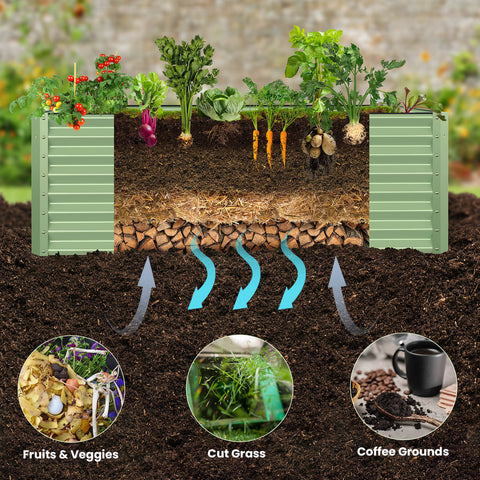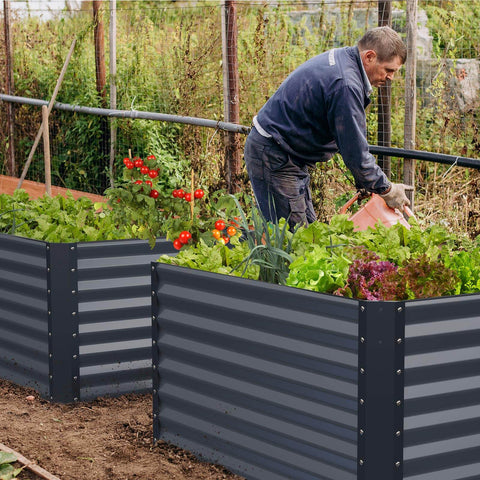Growing potatoes in raised garden beds is a great way to maximize potato production, and growing potatoes with this technique is a simple and rewarding experience. High beds are one of the best ways to grow potatoes because they thrive in loose, well-drained soil. First, because the beds are raised from the ground, it is easier to prevent weeds from growing. Also, you don't have to worry about soil compaction or going deep into the soil when harvesting. In addition, soil tends to warm faster in the spring due to direct exposure to sunlight. This helped create ideal conditions for early potato planting. Today I'm going to share with you how to grow potatoes in a raised garden bed.

Start by choosing a sunny spot for your bed, preferably one with 8-10 hours of direct sunlight per bed per day. This will ensure that your potatoes get enough heat and light for optimal growth. Also, make sure to use good quality soil that drains well and is rich in nutrients. To increase production, consider adding aged compost or fertilizer to the soil before planting. When it comes to spacing, try to keep the rows about 18-24 inches apart so the plants have plenty of room to grow. When potato plants are mature, cover them with extra soil or mulch to prevent pests and diseases. Finally make sure the potatoes are well hydrated during the growing season.
1. Prepare the soil for potato planting
You need to loosen the soil and check its pH. For best results, set the pH to 6-7 -- if the soil is too acidic or alkaline, consider adding lime or sulfur accordingly. Once the pH is at the right level, make sure to add adequate amounts of compost or aged manure to the soil. This will help provide the nutrients the potato needs to thrive. Adding a layer of mulch on top will help keep weeds away and retain moisture in the soil during dry periods.
Potatoes prefer slightly acidic soil to neutral or alkaline soil. If your soil isn't acidic enough already, you can easily adjust it by adding some sphagnum moss or pine needles. With these simple adjustments, you'll be able to create the perfect balance for potato plants to thrive!

2. Choose the potatoes you want to grow
There are several different varieties to choose from, depending on the climate you live in and the amount of space you have. In colder climates, choose potatoes labeled "early maturing" or "disease resistant." These potatoes can withstand lower temperatures and are less prone to disease and rot. In warmer regions, consider potatoes that are labeled "late ripening" or "heat resistant." When purchasing seed potatoes, check the packaging for any signs of damage or disease. Avoid any potatoes that are discolored, have soft spots, or show signs of mold -- these could spread the disease to other plants in your garden. Also, be aware of the size of the potatoes -- smaller potatoes generally produce more consistent yields than larger potatoes.
3. Plant potato tubers
Growing potato tubers is a relatively simple process, but there are a few things to keep in mind. If you're growing multiple varieties of potatoes in the same bed, make sure they don't touch or cross-pollinate each other. Cross-pollination can result in strange looking potatoes and even lower yields, so avoid them if possible. When planting potatoes, be sure to cover the tubers with several inches of soil and mulch. This will help them grow and protect them from pests. If you are planting in rows or mountains, make sure there is plenty of space between the plants.

4. Continuous care
Watering: Potatoes need a lot of water, especially if they are growing tubers. Water deeply at least once a week, more often if the weather is hot or the soil is dry. But don't overwater, as this can lead to the development of fungal diseases that can harm your plants.
Weed control: Weeds compete with your potatoes for water and nutrients. Pull weeds by hand and use mulch to prevent them from taking root again. This will also help reduce the loss of soil water, which can be beneficial in times of drought.
Fertilization: Potatoes need regular fertilization throughout the growing cycle to produce high-quality tubers with high yields. Add organic fertilizer, such as compost or dung tea, to the roots of your plants every few weeks. With these nutrients, growth will be optimal and yields will be high.
5. Harvest potatoes from raised garden beds
The timing of the harvest is critical. Potatoes should be harvested before they reach their maximum and before frost. If you wait too long, the potatoes may become too large or damaged from the cold. When harvesting potatoes, be careful not to damage them. Lightly loosen the soil around each plant and remove it from the ground with a garden fork or shovel. Take care to avoid cutting or puncturing any potatoes during this process.









